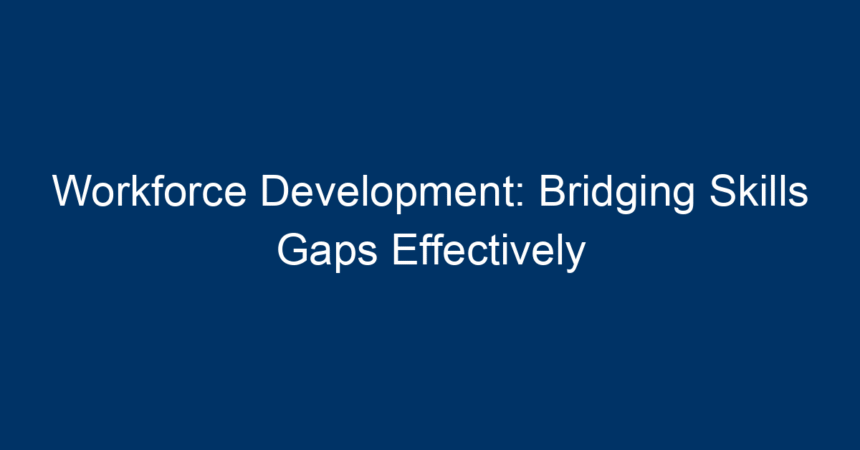In today’s rapidly changing job market, workforce development has emerged as an essential strategy for addressing skills gaps and ensuring that both employees and organizations can thrive. As industries evolve with technological advancements and shifting economic landscapes, the challenge of meeting the demands of the labor market has never been more critical. This article delves into the importance of workforce development, strategies for bridging skills gaps, and actionable insights for businesses and individuals alike.
Understanding Workforce Development
Workforce development refers to a coordinated, planned approach to workforce education and training that aligns with labor market needs. It encompasses various activities aimed at enhancing the skills and capabilities of individuals, making them more competitive in the job market.
The Importance of Workforce Development
The significance of workforce development cannot be overstated. In a global economy where companies are constantly seeking innovative solutions, having a skilled and adaptable workforce is a key driver of success. Here are some reasons why workforce development is crucial:
-
Meeting Industry Demands: As new technologies and methodologies emerge, there is an ever-pressing need for workers to adapt. Workforce development programs help individuals acquire the necessary skills to stay relevant.
-
Economic Growth: A well-trained workforce contributes to economic stability and growth by enhancing productivity, fostering entrepreneurship, and attracting investments.
-
Employee Retention: Companies that invest in workforce development can significantly reduce turnover rates. Employees are more likely to remain with organizations that offer growth and learning opportunities.
- Social Mobility: Effective workforce development programs can empower individuals from diverse backgrounds, leading to better job prospects and improved quality of life.
Identifying Skills Gaps
Conducting Skills Assessments
Before implementing workforce development initiatives, organizations must identify the specific skills gaps within their workforce. Regular skills assessments can help pinpoint areas where training is most needed. Various methods can be employed, including:
-
Surveys and Questionnaires: Gather feedback from employees regarding their current skills and areas they feel need improvement.
-
Performance Reviews: Utilize existing performance data to highlight skill deficits among employees.
- Industry Benchmarks: Compare organizational skills with industry standards to identify areas for growth.
Understanding Future Needs
It’s crucial to not only address current skills gaps but also to anticipate future workforce needs. Global trends such as automation, artificial intelligence, and remote work are reshaping the skills required in many industries. Investing in forward-thinking workforce development strategies will ensure that your team is prepared for the challenges of tomorrow.
Effective Strategies for Workforce Development
1. Training and Upskilling Programs
Organizations can create tailored training programs that align with employee needs and business objectives. These programs can take various forms:
-
On-the-Job Training: Allow employees to learn by doing tasks under the guidance of experienced colleagues.
-
Workshops and Seminars: Organize skill-based workshops that cover essential topics, from technical skills to soft skills like communication and teamwork.
- Online Learning Platforms: Utilize e-learning tools and platforms to provide employees with flexible training options.
2. Partnerships with Educational Institutions
Collaborating with local colleges and universities can be an effective way to bridge skills gaps. These partnerships can include:
-
Internship Programs: Offer students practical experience while allowing organizations to train potential future employees.
-
Customized Curriculum Development: Work with educators to tailor programs that meet specific workforce needs.
- Scholarship Opportunities: Invest in workforce development by offering scholarships to students pursuing careers in fields relevant to your industry.
3. Mentorship and Coaching
Establish a mentorship culture within your organization. Pair experienced employees with newcomers to facilitate knowledge transfer and skill development. Coaching programs can also provide personalized guidance, helping employees navigate their career paths effectively.
4. Continuous Learning Culture
Fostering a culture of continuous learning encourages employees to proactively engage in their own development. This can be achieved through:
-
Learning Incentives: Provide incentives for employees who pursue further training or education.
-
Regular Feedback: Implement regular check-ins to discuss skill development and career progression.
- Knowledge Sharing Sessions: Host regular meetings where employees can share insights or skills they’ve learned from external training.
The Role of Technology in Workforce Development
Leveraging Digital Tools
Technology plays a pivotal role in enhancing workforce development initiatives. The use of digital tools helps streamline training processes and offers innovative ways to engage employees:
-
Learning Management Systems (LMS): Implement LMS to track employee progress and provide access to a wide range of educational content.
-
Virtual Reality (VR) Training: For industries requiring hands-on experience, VR can simulate real-world scenarios, providing invaluable training without the risks associated with on-site learning.
- Data Analytics: Use data analytics to assess training effectiveness and adapt programs accordingly. By tracking employee performance, organizations can identify what works and what doesn’t.
Measuring Workforce Development Success
Key Performance Indicators (KPIs)
To evaluate the effectiveness of workforce development initiatives, organizations should establish clear KPIs. Some metrics to consider include:
-
Employee Retention Rates: Measure changes in turnover rates pre- and post-program implementation.
-
Productivity Levels: Assess whether productivity improves following training.
- Employee Satisfaction: Conduct regular surveys to gauge employee satisfaction with training programs.
Feedback and Adjustments
Continuous evaluation through feedback allows organizations to refine their workforce development strategies. Gather insights from employees about their training experiences and make necessary adjustments to meet their needs better.
Conclusion: Taking Action with Workforce Development
Bridging skills gaps through effective workforce development is not merely an option—it’s a necessity for fostering economic growth and ensuring organizational success in a competitive landscape.
By conducting skills assessments, implementing innovative training programs, and leveraging technology, employers can equip their teams with the skills needed to thrive in a constantly evolving job market.
Actionable Insights:
- Start by assessing the current skills within your organization.
- Develop partnerships with educational institutions for tailored training solutions.
- Foster a culture of continuous learning and mentorship.
- Regularly measure the effectiveness of development initiatives and adjust as needed to ensure the best outcomes.
Investing in workforce development is an investment in the future—one that benefits individuals, organizations, and the economy as a whole. Take the first step today towards bridging the skills gap within your workforce!




